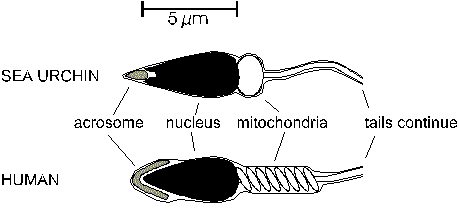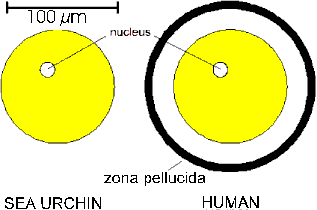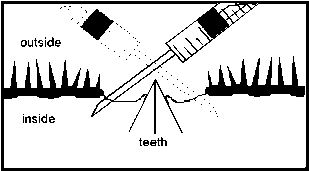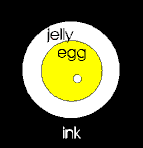- Induce spawning of gametes by injecting sea urchins with potassium chloride solution.
- Collect the gametes released.
- Compare size of eggs and sperm.
- Observe sperm motility and structure of the egg.
Timing
- 30 - 50 minutes
Background
We all produce gametes. The size, shape, etc. of sea urchin eggs and sperm are similar to our own. These easily studied eggs provide information on fertilization and development that applies to all organisms from jellies to humans. These eggs, then, provide a model embryo for understanding development in all forms.
Sea urchins and their eggs are commonly used as indicator organisms in environmental studies. The Environmental Protection Agency uses sea urchin development standards to test for the presence of water pollution. Public aquariums use an adult sea urchin's health as an indicator of the water quality in their tanks. Seeing what can interrupt or alter normal development in sea urchins provides evidence for what might harm all life in the sea and ultimately us.
Sperm:

The acrosome is much larger in human sperm because in humans the sperm has to be able to get through the zona pellucida using the enzymes in the acrosome.
Eggs:

- hydrogen atom is 0.0001 microns
- globular protein is 0.004 microns
- large virus us 0.1 micron
- E. coli bacteria is 2 microns
- Sea urchin and human sperm w/o tail is 1x5 microns
- Human red blood cell is 9 microns
- somatic cells are 10-30 microns
- amoeba is 90 microns
- sea urchin and human egg is 100 microns
- frog egg is 2000 microns
Materials:
- 0.5M potassium chloride solution (3.73g of KCL in 100ml of distilled water)
- sea water (or Instant Ocean, or Artificial Sea Water)
- fertile sea urchins
- 1-5cc syringe
- plastic or glass pasteur pipets or eyedroppers
- small tubes to store sperm (micro-centrifuge tubes work great) (1-5ml)
- beakers a little smaller in diameter than the diameter of female urchins
- sumi ink, available at most art stores, used in Asian art and calligraphy
- Optional - chloramphenicol for long term storage
- microscopes
Procedure
Making the 0.5M potassium chloride injection solution:
The molecular weight of potassium chloride (KCl) is 74.55 Therefore 74.55g/liter = 1 M.37.275g/liter = 0.5 M OR
3.73g of KCL in 100ml of distilled (or de-ionized) water = 0.5 M
One hundred milliliters is enough to do 50 urchins.
If you do not have easy access to a balance you can use teaspoon measurements.
1 level tsp of KCl = 5.35g or1 tsp of KCl in 143 ml of distilled water = 0.5 M KCl
Sea water:
It is best to use fresh sea water for fertilization of sea urchin eggs. If this is not practical a good substitute is a commercial sea water mix such as Instant Ocean, available at most pet stores. It is also possible to make artificial sea water entirely from laboratory reagents, see Artificial Sea Water.
Sea Urchins:
In most species, sexes are visually identical. You need at least one male and one female. Although the distribution of sexes is approximately equal the odds of getting at least one of each is: (If sea urchins are being shared with multiple classes then save eggs and sperm and inject only one sea urchin for demonstration purposes.)
| #of urchins | odds of at least one of each sex |
| 2 | 50% |
| 3 | 75% |
| 4 | 88% |
| 5 | 94% |
| 6 | 97% |
| 7 | 98% |
| 8 | 99% |
So a safe bet is to order at least 10 urchins, as some may not have gametes or not survive shipping.
Sea urchins can be collected only with the appropriate permits or licenses. (So be careful – collecting without a permit or license in California is a $500 fine!)
See Suppliers.
Spawning Animals:
Inject 0.5 M potassium chloride into the sea urchin.
See the spawning animation.

side view
- Inject about 0.1-0.2 ml per inch of urchin width in each side of the urchin. A total of two injections are made. It is best to use as small a needle as possible as a larger needle leaves a larger wound, subjecting the urchin to infection. (#25 - #30).
- Gently shake the urchin for a few seconds to mix the KCl solution inside the sea urchin. (shaking too hard can kill the urchin by ripping apart the delicate internal membranes).

top view
Males: (see animation) sperm are a milky white color.
- After injection, place the male urchin mouth side down onto a small dish, like a petri dish. (not under water).
- In a minute or two you will start to see the white sperm appearing on the surface of the urchin.
- Collect the sperm (dry) in a pipet or eyedropper and place it into a small test tube.
- After you have collected all that you can, place the tube into a refrigerator (not freezer) or an ice bucket with ice. Sperm will keep at 4 C for up to a week.
Females: (see animation) eggs are pale yellow to orange to dark maroon depending on species.
- After injection place the female urchin mouth side up onto a beaker full of sea water.
- The eggs will be shed into the sea water and collected at the bottom of the beaker. This can take from 10-30 minutes to finish shedding the eggs, although, within a few minutes you will have enough eggs to begin work.
- It is best to keep the eggs and the urchins at the same temperature. (Temperature is species specific.)
Observations of sperm and egg:
see Video Microscopy
How big is the egg? How big is the sperm? see Size Under the Microscope.
![]() Observation of Sperm:
Observation of Sperm:
- Touch a pipet or glass rod to the sperm, transferring a barely visible amount.
- Stir the sperm into 1-2ml of sea water.
- Transfer a drop of the sperm suspension to a microscope slide and add a cover glass.
- Observe first under low magnification, 10x objective. Notice the motility.
- Switch to higher magnification, 40x objective. Can you start to see the parts of the sperm? (This may be dependent on student ability as well as the quality of the microscope.)
Sperm move by rotating their tails like a jump rope in a spiral three dimensional motion and not in a two dimensional wave (see animation 1 and animation 2).
Further Study
Many experiments can be done observing sperm motility. Remind students that sperm motility is essential to fertilize an egg. You could try:
- Lowering the pH of the sea water by adding 1ml of vinegar in 100 ml to show effects of acid rain. (Dilute hydrochloric acid is an alternative.)
- Raising the pH with household ammonia, borax, washing soda or lye (experiment with VERY small amounts)
- Adding detergents to show effects of household pollution. (one drop of dish washing liquid in 100 ml of seawater)
- Adding a small amount of copper sulfate solution (a common garden fungicide), one drop of 1% in 100 ml, to represent pollution.
![]() Observation of Eggs:
Observation of Eggs:
- Place a drop of egg suspension on a microscope slide and observe under the microscope at low power.
- How big is the egg in microns? How big is the egg in relation to the sperm? (see Size Under The Microscope)
- Add a drop of sumi ink, mix gently, and add a cover glass. Draw what you see now? What is now visible that was not visible before? (You may even be able to see the nucleus.) Eggs will die in the ink. Wash these off and get new eggs before continuing.

Further Study
Eggs are strongly affected by their environment. Unlike the motile sperm, a dead egg can look the same as a live one. What happens when you add a small drop of concentrated eggs to a small volume of tap water? (Try one drop of eggs in 1 ml of tap water and look under the microscope as quickly as you can.)
Sea urchins are marine creatures. The composition of sea water is very different from that of fresh water. Most organisms that live in one of these environments cannot live in the other. The reason for this is the difference in "osmolarity". Sea water is hypertonic, tap water is isotonic and distilled water is hypotonic to spring water. If you have time you might try mixing a 2x sea water solution (artificial sea water) and placing the eggs in that (or add 25 g/liter sodium chloride to normal sea water as an approximation). This would be a hypertonic solution in regards to sea water, where the fresh water would be a hypotonic solution.
Math
- Determining size of each of the gametes is certainly a good math problem. See Size Under The Microscope.
species egg sperm (minus tails) L. pictus 120 microns 1x5 microns S. purpuratus 90 microns 1x5 microns S. franciscanus 90 microns 1x5 microns How long is the sperm tail? (hint: use copper sulfate – one drop of 1% in 100ml of seawater – first to stop motility)
- Determining the concentration of each gamete in the sea water is a good problem as this sets them up well for the next experiment, fertilization. Here a hemacytometer is useful. Count the eggs or sperm in a known volume in the hemacytometer and then determine the number of gametes per milliliter (see Sperm Dilution lesson).
Implications:
- How do we develop from the size of a sperm and egg to our present size and shape?
- We eat chicken eggs (a chicken gamete). In some cultures the gonads from sea urchins are regularly eaten. Have you ever tried to eat a sea urchin gonad? What does it taste like? How does it make you feel knowing you are eating gametes (Cut open a sea urchin to show the gonads)
- Why is there such a difference in the size of the egg and the sperm?
- Who expends the most energy on reproduction, male or females? Calories? Life cycles? Behavior? Body plans?
- In what way is the human body organized to facilitate reproduction and survival of our species? In sea urchins, the gonads can be up to 80% of the weight of the urchin during breeding season. Imagine what your own life would be like if that was true in humans as well. How would society be different? (see the Brooders v.s. Spawners lesson)
- Because we are more efficient organisms with internal fertilization and internal development, how has this allowed us to specialize in other ways?
Evaluation:
- Observe students actively involved in lab exercise
- Lab reports
- Implication questions
